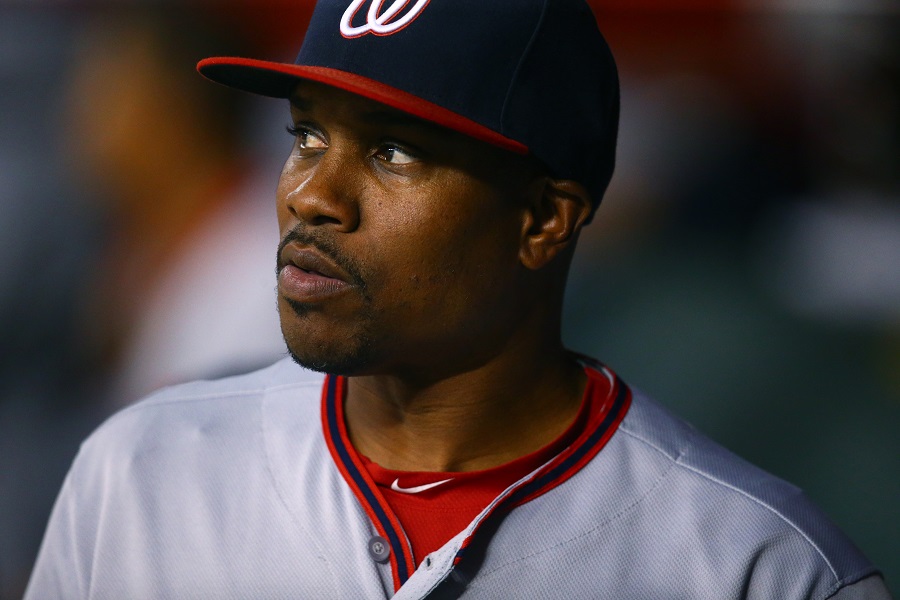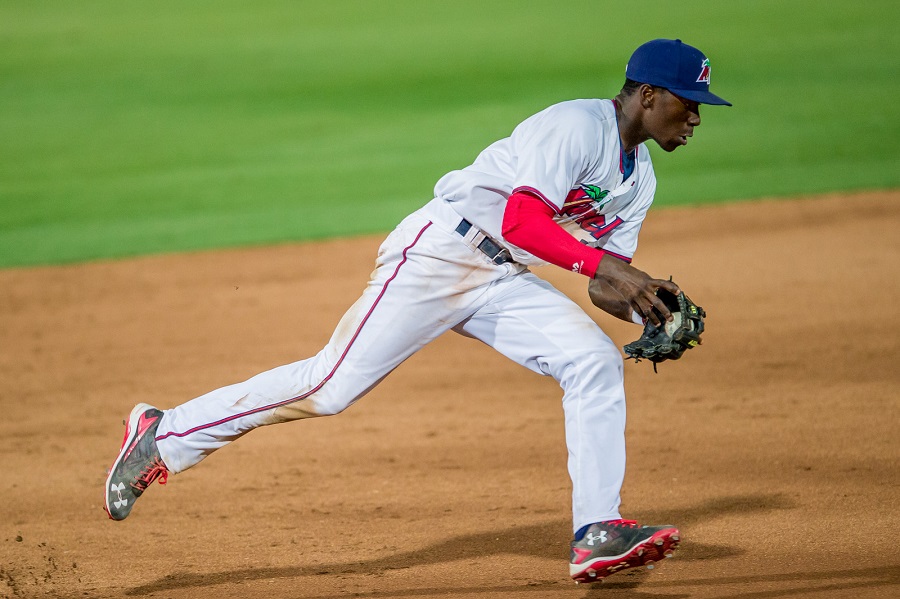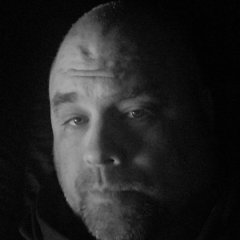Search the Community
Showing results for tags 'nick punto'.
-
Back in 2014, the Minnesota Twins used their first-round pick, 5th overall, on Nick Gordon. Brother of Dee and son of Tom, Gordon had plenty of baseball running through his bloodlines. A speedy shortstop with a quick bat, he spent seven years in the minors before making his big league debut last sea...
- 9 comments
-
- nick gordon
- tim beckham
-
(and 3 more)
Tagged with:
-
While Major League Baseball has decided to lock out the players and freeze big-league transactions, Minnesota has continued making minor league moves. Daniel Robertson and Tim Beckham were signed recently and could be depth fits for the 26-man roster, but what if this club already has a utility play...
- 9 replies
-
- nick gordon
- tim beckham
-
(and 3 more)
Tagged with:
-
It feels like it may be time to shake things up with this Minnesota Twins roster. One way to accomplish that would be by making a challenge trade, swapping big league pieces for big league pieces. It’s a risky endeavor. Let’s take a look back at some of these deals. There are quite a few of t...
- 9 replies
-
- joe nathan
- francisco liriano
-
(and 3 more)
Tagged with:
-
- 9 comments
-
- joe nathan
- francisco liriano
-
(and 3 more)
Tagged with:
-
There is almost exactly nothing happening in baseball right now, so it’s a good time for some nostalgia. Follow me on a trip down memory lane to 2006 and the team that made me a baseball fan (and made me think Boof Bonser was good). As I write this, I’m two weeks away from turning 23 years old...
- 3 replies
-
- boof bonser
- nick punto
-
(and 3 more)
Tagged with:
-
As I write this, I’m two weeks away from turning 23 years old, which means I was seven when the 2006 Minnesota Twins won the American League Central. It also means I have no meaningful memory of a Twins playoff win, but whatever. I digress. The 2006 season was the first in which I really followed th...
- 3 comments
-
- boof bonser
- nick punto
-
(and 3 more)
Tagged with:
-
Initial Trade: February 6, 1998 Knoblauch wanted a new home, and the Yankees were looking for a lead-off hitter for teams that won three straight championships. The Twins were able to acquire Brian Buchanan, Cristian Guzman, Eric Milton, and Danny Mota. Mota never panned out as he only appeared in f...
- 6 comments
-
- chuck knoblauch
- nick punto
-
(and 3 more)
Tagged with:
-

Punto Wonders If Sliding Headfirst Into Virus Would Work
RandBalls Stu posted an article in Just For Fun
Sources close to former Minnesota Twins infielder Nick Punto say the retired major leaguer has taken an interest in public health and using his unique skill set to mitigate the COVID-19 outbreak. “He’s done the reading, he’s aware of the vaccine progress, and now he has one question,” said a source... -
When attempting to compile names for this list I couldn’t help but enjoy the trip down memory lane. I’m not big on re-watching previously completed sporting contests. The idea of the already known result isn’t all that exciting to me. Specific plays or portions can be fun, but much of the programmin...
- 23 comments
-
- minnesota twins
- jacque jones
-
(and 3 more)
Tagged with:
-
The 2009 squad hit a grand total of 172 round-trippers. Only four guys launched more than 15 on the year, and in the decisive 6-5 walkoff victory just two balls left the park for the home team. One of them came from a traditional slugger in the form of Jason Kubel, while the other was deposited into...
- 3 comments
-
- minnesota twins
- matt tolbert
-
(and 3 more)
Tagged with:
-
Believe it or not, Tuesday’s match-up between the Twins and the Yankees will be the sixth AL Wild Card game. Major League Baseball expanded their playoff format in 2012 to add more drama with a one-game playoff to decide who would move on to face the best regular season team. There has been some dra...
- 7 replies
-
- carlos gomez
- nick punto
-
(and 2 more)
Tagged with:
-
2012 AL Wild Card Game Baltimore Orioles 5, Texas Rangers 1 Yu Darvish faced off against Joe Saunders in the AL’s inaugural Wild Card game. Both clubs scored runs in the first frame as the starters worked out some kinks. From there, Darvish and Saunders pitched shutout baseball until the sixth. Adam...
- 7 comments
-
- carlos gomez
- nick punto
-
(and 2 more)
Tagged with:
-
Eduardo Escobar, Danny Santana, Pedro Florimon, Jamey Carroll, Alexi Casilla, JJ Hardy, Nick Punto, Adam Everett, Jason Bartlett, and Juan Castro have all taken their turn as Minnesota's Opening Day starter. New Twins chief baseball officer Derek Falvey will try to end this disastrous trend in the y...
- 38 comments
-
- nick gordon
- jorge polanco
-
(and 3 more)
Tagged with:
-
Perhaps no Twin better typified the mid-2000s teams than Nick Punto. The nibbliest of the piranhas, Punto played every defensive position over the course of his career except pitcher and catcher, and played most of them better than the average major leaguer. In fact, he had nearly 4000 chances to ma...
-
The fact that his inclusion in the lineup on a game in and game out basis was as controversial as it was is a great testament to the fact that he was 1) versatile 2) a strong defender and 3) a virtual waste of a plate appearance. For his career, he was about 23 percent worse than the average major l...
-
Nick Punto and Miguel Sano: Getting The Good To Outweigh The Bad
dwade posted a blog entry in Unkind Bounces
Perhaps no Twin better typified the mid-2000s teams than Nick Punto. The nibbliest of the piranhas, Punto played every defensive position over the course of his career except pitcher and catcher, and played most of them better than the average major leaguer. In fact, he had nearly 4000 chances to ma...-
- miguel sano
- nick punto
-
(and 3 more)
Tagged with:
-
Local Celebrity Offers To Pay Twins To Bring Back Fan Favorite
Mike Bates posted an article in Twins
-
The Twins have drafted ten players so far in the 2015 first-year players draft (Rule 4 draft). After making two picks on Monday night and eight on Tuesday afternoon, the Twins will draft thirty players on Wednesday. Yesterday, I showed that there are many examples of very good MLB players that have...
- 3 replies
-
- kent hrbek
- pat neshek
-
(and 1 more)
Tagged with:
-
Continue on to read some of the Twins top picks from rounds 11 through 40. 11th Round 1967 – Al Hrabosky – LHP – High School in California – WAR 10-6 Hrabosky didn’t sign after he was drafted by the Twins. He went to Cal State-Fullerton. Two years later, he was a first-round pick by the Cardinals. T...
- 3 comments
-
- kent hrbek
- pat neshek
-
(and 1 more)
Tagged with:
-
Aaron and John talk about the Twins' top 10 prospects, Ron Gardenhire's plans for 2015, the big Miguel Sano comeback, eating and drinking at New Bohemia, Nick Punto's retirement, billion-dollar TV deals, how to get a proper anti-social haircut, Jose Berrios going topless, moving day, and mailbag que...
-
- aaron gleeman
- ron gardenhire
-
(and 1 more)
Tagged with:
-

Gleeman & the Geek, Episode 182: Topless Prospects and Talkless Haircuts
John Bonnes posted an article in Twins
-
- aaron gleeman
- ron gardenhire
-
(and 1 more)
Tagged with:
-
Recent Articles
-
Recent Posts
-
3
Hey, look here
Whoooooooo Ranked ProspectsTurangChourioQueroFrelickBillWilburSpankyEdgarJohn NOOOOOOOOOO...
By Brock Beauchamp
Last post date -
0
Can Jorge López Rediscover His First-Half Success?
The Twins made a much-needed trade for an all-star reliever at last year’s deadline, but what they got fell short of e...
By Lou Hennessy
Last post date
-
Blog Entries
-
Who's Online (See full list)
- There are no registered users currently online



























